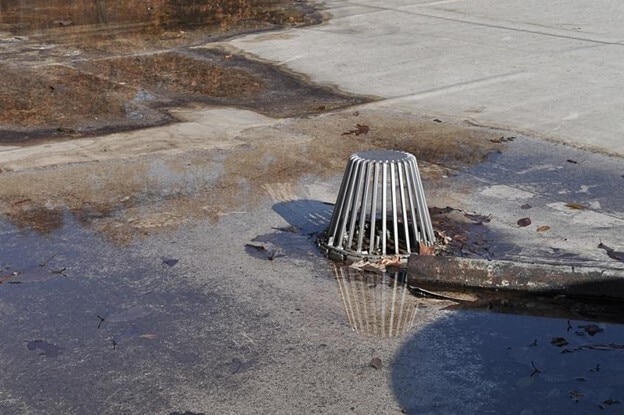Une toiture commerciale à faible pente est conçue pour empêcher les éléments de s'infiltrer dans le bâtiment. En cas de fortes pluies, l'eau qui ne peut s'écouler peut stagner sur le toit. A roof drain prevents water from ponding by providing a way for it to leave the roof, and regular commercial drain maintenance ensures its continued performance.
Although commercial buildings may appear to have flat roofs, some roofs have slopes built into the structure or require added slopes, typically achieved with tapered insulation to facilitate water drainage. Cette pente est conçue pour acheminer l’eau vers le drain, afin qu’elle ne stagne pas sur le toit, ce qui pourrait endommager le système de toiture ou la structure. Une eau stagnante peut graduellement user certains matériaux de toiture et entraîner une dégradation, des fuites ou des dommages. It can also promote algae and plant growth and attract nuisances such as birds and insects.
Guiding Water off the Roof
Residential roofs have gravity on their side-water flows down the slopes into gutters that transport it away from the home. Commercial buildings with low-slope roofs have to work a little harder to remove water, which is where roof drains come into play.
The roofing system design can help guide water toward the drains. It often involves using tapered insulation such as GAF EnergyGuard™ tapered polyiso insulation. Les deux panneaux biseautés les plus utilisés permettent d’obtenir une pente de 1/8 de pouce ou de 1/4 de pouce par pied. This slight slope prevents water from standing on the roof, forcing it toward a drain strategically installed at various low points on the roof with crickets and saddles.
Drain placement is particularly essential when the parapet wall sheds water. Pour acheminer l’eau vers le drain ou la gouttière, des dos d’âne biseautés sont généralement installés au niveau des coins et entre les drains afin de diriger le flux et de réduire l’accumulation d’eau. This water must flow down the roof side of the parapet wall and follow the roof slope to reach the drain.
3 Common Types of Roof Drains
Inner Drains
Inner drains are connected to sloped pipes under the roof that carry water off the roof and away from the building. They typically rely on gravity and the roof's slope to get water to the drain.
Scuppers
Scuppers are found at the roof's edge, usually installed through a hole in the parapet wall. They're designed to drain water from the roof into a downspout or may extend out from the building to shed water.
Siphonic Drains
Siphonic drains feature a baffle that keeps air out and allows water to fill the pipes. Une fois les tuyaux remplis, le manque d'air crée un vide qui siphonne rapidement l'eau du toit. The baffle also keeps leaves and debris from gathering in the drain and causing a blockage.
Caring for and Maintaining Roof Drains
Inspecting and maintaining roof drains should be part of your regular roof inspections. Étant donné que les drains de toit sont situés à des points bas du toit, les débris et les feuilles s'y accumulent facilement. Le nettoyage des débris est essentiel au bon fonctionnement des drains. Les obstructions favorisent l'accumulation d'eau stagnante sur le toit, ce qui peut provoquer des problèmes structurels sur le bâtiment. Even just an inch of standing water can add thousands of pounds of weight to the roof, reinforcing the need for regular commercial drain maintenance.
Advancing Roof Drain Maintenance with Technology
GAF recently introduced the Steely Drain™. Cette solution de drain de toit utilise la technologie pour permettre aux entrepreneurs de mettre en place leur calendrier d’entretien grâce à des rappels les invitant à communiquer avec les propriétaires ou les gestionnaires d’un bien. This contractor-inspired drain is made of 316L marine-grade stainless steel, making it ideal for tough environments that require exceptional corrosion resistance.
Steely Drain™ features a QR code etched onto the top that you can scan with your smartphone to instantly view information about the roofing system. This data can include the contact information of the contractor who installed the system, the architect and consultants for the project, and the roofing system details if all information is inputted.
This critical data is managed from a convenient GAF-hosted dashboard and plays an important role in the roof's maintenance plan. Les entrepreneurs peuvent configurer et recevoir des rappels par courriel quand il est temps de réaliser des inspections planifiées des toits et des drains. The dashboard also eliminates the need for core cuts since every detail of the roofing system is available through the QR code-from the deck type to the cover board, underlayment, insulation type and thickness, to the final membrane.
Knowledge Is Key to Success
When properly installed and maintained, roof drains can keep the rooftop free of standing water for many years. Vous voulez en savoir plus? Explore how the Steely Drain™ can help you with your ongoing maintenance programs. You can also visit the GAF CARE Contractor Training Center to gain additional tips and access valuable training courses that allow you to learn at your own pace.

